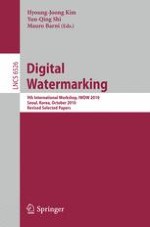2011 | Book
Digital Watermarking
9th International Workshop, IWDW 2010, Seoul, Korea, October 1-3, 2010, Revised Selected Papers
Editors: Hyoung-Joong Kim, Yun Qing Shi, Mauro Barni
Publisher: Springer Berlin Heidelberg
Book Series : Lecture Notes in Computer Science
